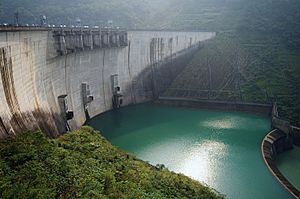Load following power plant facts for kids

A load following power plant is a special kind of power plant. It can change how much electricity it makes very quickly. This helps it match the amount of electricity people need at different times of the day. Think of it like a car that can speed up or slow down easily to keep up with traffic.
These power plants are usually somewhere in the middle when it comes to how much they cost to build, how much the electricity they make costs, and how well they work. They are not as steady as a base load power plant (which runs all the time) and not as quick as a peaking power plant (which only turns on for short, very busy times).
Contents
What is a Load Following Power Plant?
A load following power plant helps keep the electricity grid stable. The amount of electricity people use changes a lot during the day. For example, more electricity is used in the morning when people wake up, and in the evening when they come home. During the night, less electricity is needed. Load following plants can increase or decrease their power output to match these changes. This makes sure there is always enough electricity without wasting any.
How Do They Work?
These power plants have special features that let them change their power output quickly. They can respond to signals from the electricity grid operator. If more power is needed, they can generate more. If less power is needed, they can reduce their output. This flexibility is very important for managing the flow of electricity.
Types of Load Following Power Plants
Many different types of power plants can act as load following plants. The most common and effective ones are:
- Hydroelectric Power Plants: These use the power of moving water to make electricity. They are excellent at load following. Operators can quickly open or close gates to control how much water flows through the turbines. This changes the amount of electricity produced almost instantly. The image at the top of this article shows a hydroelectric plant.
- Natural Gas Power Plants: These plants burn natural gas to create steam, which then spins turbines. They can also start up and shut down relatively quickly. This makes them good for adjusting to changing electricity needs.
- Some Coal Power Plants: While many coal plants are used for base load, some newer ones are designed to be more flexible. They can adjust their output to a certain extent.
Why Are They Important?
Load following power plants are super important for a few reasons:
- Balancing Supply and Demand: They make sure that the amount of electricity being made always matches the amount being used. This prevents blackouts or power surges.
- Supporting Renewable Energy: Sources like wind power and solar power are great, but they don't always produce electricity steadily. Wind turbines only work when the wind blows, and solar panels only work when the sun shines. Load following plants can quickly fill in the gaps when these renewable sources are not producing enough power. They can also reduce their output when there is a lot of wind or solar power available.
- Grid Stability: By quickly adjusting their output, these plants help keep the entire electricity grid stable and reliable.
Images for kids


